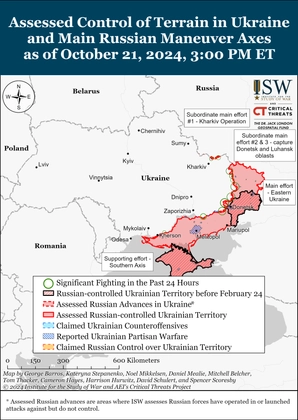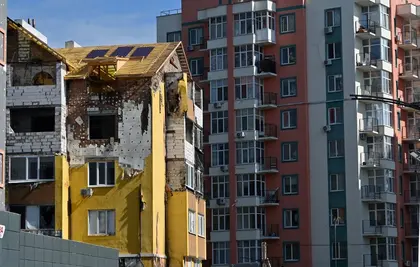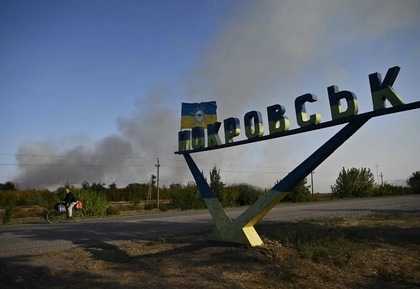Ursula von der Leyen, President of the European Commission, made a strong and unequivocal statement on Wednesday, Nov. 30. She said Russia must pay for the reconstruction of Ukraine and the West has the financial means to make that happen.
300 billion euros of Russia’s Central Bank reserves have been blocked in Western banks and 19 billion euros of assets belonging to Russian oligarchs have been frozen.
JOIN US ON TELEGRAM
Follow our coverage of the war on the @Kyivpost_official.
Von der Leyen proposed to create, in the short term, a structure to manage and invest these funds, to use the proceeds for Ukraine. And longer term, when sanctions have been lifted, these funds would be used to pay compensation in full for the ruin and damage caused by Russian aggression.
This is a very welcome development. It is clear that hundreds of billions of euros will be needed to rebuild Ukraine’s devastated economy and, it is, of course, Russia, the aggressor, that has to cover the bill.
The frozen Russian assets are an obvious source of funding, and the European Commission’s readiness to move forward with using them is quite laudable.
Yet we need to be sanguine about how challenging the massive project of reconstructing Ukraine after the war really is – and that the source of funding is not the only issue that needs to be tackled for the reconstruction to be successful.
The economic damage from the war is massive, with estimates of losses incurred running into billions of dollars. Just restoring what’s been destroyed is a massive project in itself.

ISW Russian Offensive Campaign Assessment, October, 22, 2024
Yet, the war only exacerbated the issue that existed before it – the underdeveloped condition of the Ukrainian economy, which made the country one of the poorest in Europe.
This economic weakness undoubtedly contributed to making the country look vulnerable to the Russians. If Ukraine is to be turned into a strong bulwark against aggression on Europe’s Eastern flank – the best way to stabilize the entire region and avoid conflicts in future – proper economic modernization of the country is a necessary precondition.
Post-war reconstruction should, therefore, be focused not only on repairing the damage that has been caused but on modernizing Ukraine to the level of a strong Eastern European economy. It should be capable of sustaining a strong military on its own, showcase the clear superiority of its democratic pro-Western development path to all other post-Soviet nations and prepare for eventual accession to the EU with maximum economic benefit to the bloc as a whole.
Current thinking on Ukraine’s rebuilding is focused, in the main, on various intergovernmental mechanisms of transferring financial resources.
Discussions are continuing on the governance mechanisms and ownership of resources.
But for the reconstruction project to succeed it is not enough to just allocate funds, as they need to be allocated in the manner that would be effective and bring results.
If, as currently discussed, capital is allocated through public institutions, the results are likely to be underwhelming.
On one hand, it isn’t clear that in their current state Ukraine’s public institutions are capable of capital allocation on a massive scale, given the long legacy of corruption and inefficiency.
On the other hand, the available international public institutions (that are the most likely vehicles to provide funds) tend to be heavily bureaucratized and rigid.
Their capacity to process and manage a multitude of complex investment projects (which is what reconstruction is ultimately all about) is quite limited.
For this reconstruction project to be successful, the private sector needs to be in the driver’s seat – like it was in other Eastern European countries that managed to achieve rapid economic development.
This means that at least a large part of reconstruction funding should be allocated via financial mechanisms that enable credible and reputable private sector players – both Ukrainian and international – to have access to it on a competitive basis.
The emphasis should be put on “credible and reputable”, as it is quite clear by now that murky oligarchic businesses are incapable of building a modern economy, not to mention their susceptibility to Russian influence.
To achieve this, something like a two-tier mechanism can be envisaged.
A special financial organization – let’s call it the Ukraine Recovery Fund – could be created to hold and manage the reconstruction funds.
This entity would allocate funding not directly, but through prime international banks and large investment funds, by providing them with capital to issue loans and provide other forms of financing.
The only limitation is that this money would have to go exclusively for the purposes of funding investment projects in Ukraine as part of the rebuilding effort.
The Ukraine Recovery Fund would only monitor that banks and investment funds do, in fact, conform to such policy.
The cost of capital would be determined on a competitive basis, but the Fund would cover all systemic risks stemming from Ukraine’s vulnerable position and damaged economy, thereby helping to keep the cost of money cheap.
To keep the legal risks for investors as low as possible, the contracts within the scope of the program would operate under English law and litigations related to them would be held at international commercial courts.
All the commercial and investment decisions would then be taken by private sector investors. This would ensure equal access to the program of financing Ukraine’s reconstruction to anyone possessing the necessary competencies for doing business with a large international financial institution – which is exactly the type of investor that Ukraine needs for successful reconstruction.
While the systemic war-related and macroeconomic risks would be covered by the Ukraine Recovery Fund, the investors themselves would have to ensure the viability of investment projects and would compete for them.
Moreover, the public sector would be able to fund its own investment projects using the same mechanism and competing in a transparent way with the private sector for capital.
The successful post-war modernization of Ukraine is critical for the peace and stability of the entire region – if not the whole world. The private sector and competitive markets are the forces that have modernized all successful Eastern European economies.
It’s high time to combine these two ideas into an integrated concept of Ukraine’s reconstruction project – one based on entrepreneurship and the vigor of the private sector.
The views expressed in this article are the author’s and not necessarily those of Kyiv Post.
You can also highlight the text and press Ctrl + Enter






